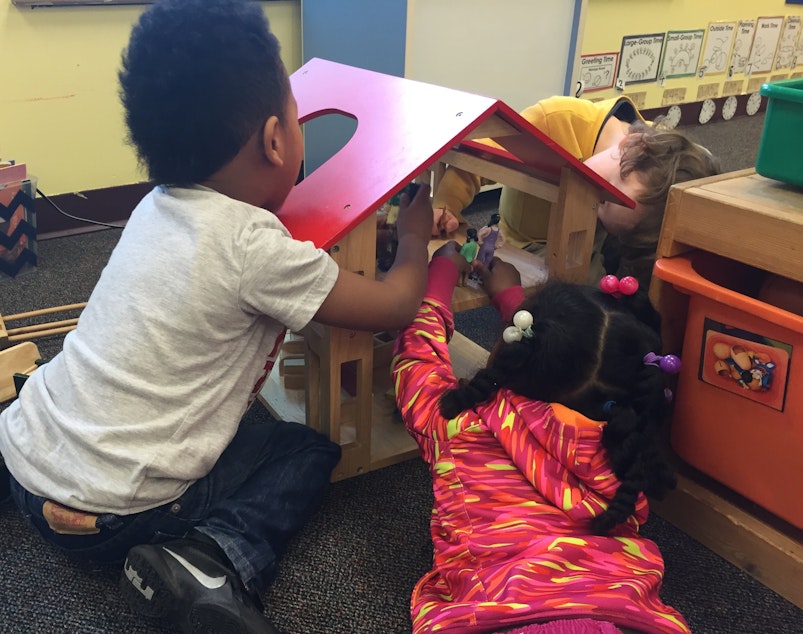Qualified Providers, Space Hard To Find For Seattle Preschool Program

The promise of the city of Seattle’s new subsidized preschool program — to bring low- or no-cost preschool to three- and four-year-olds across the city — is facing a challenge as the city struggles to find space and providers for the second year.
Voters approved the four-year pilot program in 2014 as a way to help get kids from low-income families ready for kindergarten. While there are other government-subsidized preschools, like Head Start, wait lists are long, and only a small percentage of eligible children have seats.
The Seattle Preschool Program opened in 15 classrooms in fall 2015; they were mostly existing providers that met the city’s high preschool standards, like Launch at Leschi Elementary School, where Mariko Taylor recently arrived early for her parent-teacher conference.
Taylor’s eyes light up when she talks about how much her four-year-old daughter is learning in the city’s preschool program. "She learned some math, she’s learning how to read already, writing – I just didn’t expect her to learn all of this until kindergarten."
Taylor says until this year, her daughter was in a small, home-based daycare that cost twice as much.
Sponsored
"She would have stayed in daycare if this program wasn’t here. It’s just more of a combination of smaller kids, including babies, and I don’t feel it would have taught her that much. She would have gone into kindergarten clueless unless I taught her some stuff."
“Preschool is off to a strong and wonderful start. So we’re excited," said Seattle City Councilmember Tim Burgess, who conceived of the preschool program.
"But we face a big, little climb here, because this coming September we have to expand to 39 classrooms and almost 800 kids being served," Burgess said.
The program is scheduled to ramp up annually, with a goal of 70 classrooms in 2017, and 100 in 2018 to serve a final count of 2,000 students.
The city still needs to find a dozen more classrooms just to stay on track for this fall.
Sponsored
"The pressures we’re feeling as we launch the program are focused on the availability of credentialed staff and the availability of space," Burgess said.
Those are challenges the city anticipated.
The program requires that teachers have bachelor’s degrees or be working toward them – unless they can show substantial preschool experience. But few preschool teachers have bachelor’s degrees. For that reason, and others, only a small number of the preschool providers that have expressed interest in joining the city’s program meet the standards.
The city offers full tuition assistance to providers in the preschool program who are working toward early education credentials. For providers that don't yet qualify, it created a separate track of subsidized preschool: Seattle Preschool Program Pathway, which is funded through the Families and Education Levy.
Meanwhile, other preschools prefer to remain half-day, or to teach kids in their own style and avoid city bureaucracy.
Sponsored
Some classrooms the city does have its eye on are in Seattle Public Schools. The preschool program is already in three elementary schools – and Burgess says there is potential for huge growth.
"Nearly every elementary school in Seattle has a preschool program or some form of child care today," Burgess said. "So, working with the city, we’re hoping the district will, over time, convert those existing classrooms that are being used for preschool or child care to be part of the Seattle Preschool Program."
Not so fast, says Seattle School Board Member Rick Burke. He likes the idea of affordable preschool for everyone who wants it, and says it makes sense to locate some sites in the city’s public elementary schools – at least in theory. But the district is facing a major space crunch that’s already squeezing out before- and after-school programs that families have relied on for years.
"These are programs that actually allow parents to have a full-time job. And so in some cases losing these programs has a direct impact on a family’s ability to earn an income. And that’s not something I take lightly," Burke said.
Burke says today, it's existing child care getting forced out of district buildings. Tomorrow, it could be the city’s preschool classrooms. "I don’t want to do something that seems like a good idea that we then have to evict or displace or that we can’t sustain in two years or three years," Burke said.
Sponsored
And then, Burke says, there’s the issue of rent. The city doesn’t pay anything to use district classrooms. Burke has been trying to find out how much rent the district is missing out on.
"It’s not that much money," Burke said. "But the concern is that it’s setting a precedent. If this is something that we feel is a high value to our families and continues to grow, we put a structure in place that is fiscally not responsible, the more it grows, the more of a disadvantage the district is placed in."
The school board votes Wednesday whether to let the city use four more classrooms for the preschool program – contingent upon available space.
City officials hope to announce the next round of preschool locations by early May.

